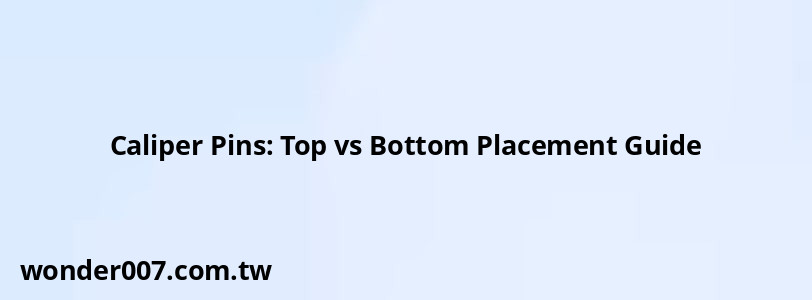Caliper Pins: Top vs Bottom Placement Guide

Caliper Pin Basics
Brake caliper pins, also known as slide pins or guide pins, are crucial components of disc brake systems. They allow the caliper to move smoothly, ensuring even pressure distribution on both sides of the brake rotor. There are typically two pins per caliper: one on top and one on bottom.
Top vs Bottom Pin Placement
The placement of caliper pins is not arbitrary. In most cases, the pin with the rubber bushing or sleeve goes on the bottom, while the pin without the bushing goes on top. This configuration helps with proper caliper alignment and movement during braking.
Bottom Pin Characteristics
- Usually has a rubber bushing or sleeve
- Often referred to as the trailing pin
- Helps absorb vibrations and reduce noise
Top Pin Characteristics
- Typically lacks a rubber bushing
- Often called the leading pin
- Provides more rigid support for the caliper
Importance of Correct Placement
Proper pin placement is crucial for:
- Even brake pad wear
- Optimal braking performance
- Reduction of brake noise and vibration
Incorrect placement can lead to uneven brake pad wear, reduced braking efficiency, and potential safety issues.
Identifying Pin Types
To determine which pin goes where:
- Look for the pin with a rubber bushing or sleeve
- Check for any markings or notches on the pins
- Consult your vehicle's service manual for specific guidance
Installation Tips
When installing caliper pins:
- Clean the pins and bores thoroughly
- Apply appropriate brake grease to the pins
- Ensure the rubber bushings are in good condition
- Verify smooth sliding motion after installation
Common Mistakes to Avoid
- Mixing up top and bottom pins
- Over-greasing the pins
- Failing to clean the pin bores
- Ignoring worn or damaged rubber bushings
Maintenance and Inspection
Regularly inspect your caliper pins for:
- Corrosion or rust
- Bent or damaged pins
- Worn or cracked rubber bushings
- Restricted movement
Proper maintenance ensures longevity and optimal brake performance.
FAQs About Caliper Pins
- How often should I replace caliper pins?
Typically, caliper pins should be inspected and serviced during brake pad replacements or if you experience brake issues. - Can I use any grease on caliper pins?
No, use only brake-specific, high-temperature grease that's compatible with rubber components. - What happens if I install the pins incorrectly?
Incorrect installation can lead to uneven brake pad wear, reduced braking performance, and potential safety hazards.
Related Posts
-
2009 Hyundai Sonata Radio Wiring Diagram: Complete Guide
29-01-2025 • 181 views -
How to Open a Mazda Key Fob: A Complete Guide
26-01-2025 • 134 views -
Key Fob for 2003 Mercury Mountaineer: Essential Guide
26-01-2025 • 166 views -
Buick Rendezvous Catalytic Converter Count Guide
29-01-2025 • 240 views -
Control Module Power Circuit Low Voltage: Essential Guide
26-01-2025 • 163 views
Latest Posts
-
How To Turn Off Paddle Shifters Mercedes
01-02-2025 • 333 views -
2015 Chevy Traverse AC Recharge Port Location
01-02-2025 • 365 views -
Power Steering Fluid Leak On Passenger Side
01-02-2025 • 419 views -
Are O2 Sensors Covered Under Warranty
01-02-2025 • 338 views -
Rear Brake Caliper Piston Won't Compress
01-02-2025 • 312 views
Popular Posts
-
Hino Warning Lights: Understanding Dashboard Alerts
26-01-2025 • 633 views -
EPC Light: Understanding Causes and Solutions
26-01-2025 • 1019 views -
Power Steering and ABS Light On: Causes and Solutions
27-01-2025 • 610 views -
V12 Engine Costs: What You Need to Know
26-01-2025 • 629 views -
EPC Warning Light: What It Means for Your Vehicle
27-01-2025 • 591 views
